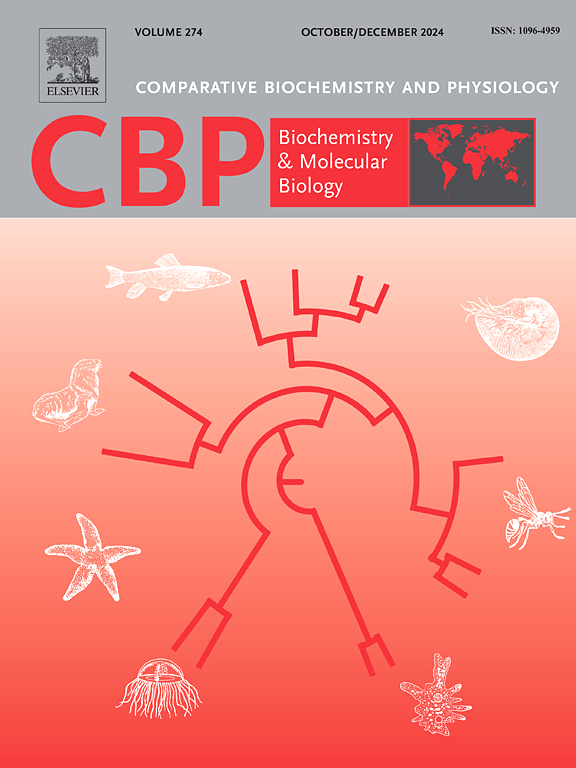Metabolic biochemistry of the fighting limbs and muscles of the freshwater prawn, Macrobrachium rosenbergii, reflects agonistic behavior
IF 1.8
3区 生物学
Q4 BIOCHEMISTRY & MOLECULAR BIOLOGY
Comparative Biochemistry and Physiology B-Biochemistry & Molecular Biology
Pub Date : 2025-07-23
DOI:10.1016/j.cbpb.2025.111137
引用次数: 0
Abstract
This study investigated the behavioral and physiological responses of the freshwater prawn Macrobrachium rosenbergii in relation to fighting activity, aiming to elucidate how energy metabolism varies across locomotory organs under different combat durations. Based on observed fighting times, individuals were divided into control (no fighting), short-duration (16.67 ± 8.22 min), and long-duration (38.33 ± 9.65 min) groups. The movement frequency of the second pereiopods, pleopods, and uropods, along with energy substrates and metabolic enzyme activities in these appendages and abdominal muscles, was analyzed. Results showed that the second pereiopods exhibited the most pronounced increase in beating frequency during prolonged fighting, followed by pleopods and uropods, reflecting their hierarchical involvement in locomotion and aggression. Glycogen content decreased significantly with fighting duration, with the greatest depletion observed in the second pereiopods (up to 36.78 %), compared to moderate decreases in pleopods and abdominal muscles. This indicates a dominant metabolic burden on primary combat appendages. Long-duration fighting induced significant increases in lactate levels, as well as hexokinase (HK) and lactate dehydrogenase (LDH) activities in the second pereiopods and abdominal muscles, suggesting a shift toward anaerobic metabolism. In contrast, short-duration fighting was characterized by elevated malate dehydrogenase (MDH) and cytochrome c oxidase (COX) activities in the second pereiopods and pleopods, reflecting reliance on aerobic pathways. These results demonstrate that M. rosenbergii adopts organ-specific metabolic strategies during aggression. This mechanistic insight lays the groundwork for future aquaculture applications involving behavioral conditioning, dietary interventions, and selective breeding to reduce energy loss and improve animal welfare in intensive farming systems.

罗氏沼虾(Macrobrachium rosenbergii)战斗肢体和肌肉的代谢生化反应反映了竞争行为
本研究研究了罗氏沼虾(Macrobrachium rosenbergii)与战斗活动相关的行为和生理反应,旨在阐明不同战斗持续时间下运动器官的能量代谢变化。根据观察到的打斗时间,将个体分为对照组(无打斗)、短时组(16.67±8.22 min)和长时间组(38.33±9.65 min)。分析了第二知觉足类、多足类和尾足类动物的运动频率,以及这些附属物和腹部肌肉的能量底物和代谢酶活性。结果表明,在长时间的打斗中,第二感觉足类动物的殴打频率增加最为明显,其次是pleopod和uro足类动物,这反映了它们在运动和攻击方面的等级参与。糖原含量随着战斗时间的延长而显著下降,第二准足类动物的糖原消耗最多(高达36.78%),而pleopod和腹部肌肉的糖原含量则略有下降。这表明主要战斗附属物的代谢负担占主导地位。长时间的战斗导致第二表足类动物和腹部肌肉中乳酸水平以及己糖激酶(HK)和乳酸脱氢酶(LDH)活性的显著增加,表明向无氧代谢的转变。相比之下,短时间战斗的特征是第二表足类和多足类动物的苹果酸脱氢酶(MDH)和细胞色素c氧化酶(COX)活性升高,反映了对有氧途径的依赖。这些结果表明罗氏芽孢杆菌在攻击过程中采用了器官特异性代谢策略。这一机制见解为未来水产养殖应用奠定了基础,包括行为调节、饮食干预和选择性育种,以减少集约化养殖系统中的能量损失和改善动物福利。
本文章由计算机程序翻译,如有差异,请以英文原文为准。
求助全文
约1分钟内获得全文
求助全文
来源期刊
CiteScore
4.60
自引率
4.50%
发文量
77
审稿时长
22 days
期刊介绍:
Comparative Biochemistry & Physiology (CBP) publishes papers in comparative, environmental and evolutionary physiology.
Part B: Biochemical and Molecular Biology (CBPB), focuses on biochemical physiology, primarily bioenergetics/energy metabolism, cell biology, cellular stress responses, enzymology, intermediary metabolism, macromolecular structure and function, gene regulation, evolutionary genetics. Most studies focus on biochemical or molecular analyses that have clear ramifications for physiological processes.

 求助内容:
求助内容: 应助结果提醒方式:
应助结果提醒方式:


